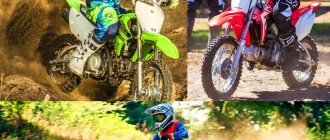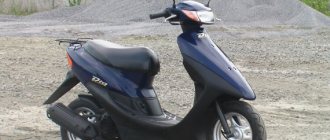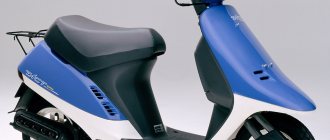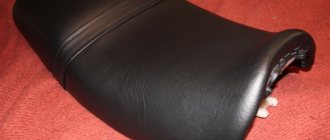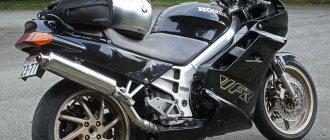Honda CBR 929RR
The Honda CBR 929, which hit the market in 2000, was Honda's first step in its pursuit of regaining leadership in the supersport class and achieving the alluring displacement of 1000cc.
The Honda brand needed a motorcycle that would support and develop the traditions of the legendary CBR 900, thanks to which Honda in the early 90s of the last century became the absolute leader in the supersport class, but already in 1997 the company faced serious competition in the “liters” – the newly appeared Yamaha R1 and the heavily modernized Suzuki GSX-R 1000 became serious market players. The new product, which was released in 2000 (CBR929RR), managed not only to preserve, but also to increase all the advantages of its predecessor, the legendary “919”. A reliable and obedient engine with good output and excellent handling were highly appreciated by the owners, and the great predisposition to tuning is still especially appreciated by fans of motorcycle stunts (it is not for nothing that specimens converted for stunt riding occupy not the least place among other equipment in this niche). Although standard specimens are quite capable of “hooliganism”. Tradition is tradition, but as the Black Queen told Alice from Lewis Carroll's famous fairy tale: “To even stay in one place, you have to run very fast.” And “929”, in an attempt to catch up with its competitors, took a “low start”: in relation to its predecessors, the model underwent radical operations to lose weight and rejuvenate. It appeared during a period of massive use of the latest technologies and materials (such as titanium, for example). Compared to earlier models (especially the first 1992 model with ugly headlights), the new CBS has acquired a very attractive appearance. Sitting behind the wheel and looking at the huge, plump fuel tank can remove any doubts about its “class identity”. But remember: “to just stay in the same place, you have to run very fast!” And in 2002, Honda went all-in by releasing a new model, which received the index “954” (corresponding to the engine displacement). So, in 2002, the next “Fire Blade” underwent a facelift and went through technical re-equipment, receiving the name CBR954RR. The new, “faceted” headlight and the same light at the rear of the motorcycle looked very attractive. It is quite obvious that with the help of the new product, Honda hoped to quickly catch up with its competitors. There was also some “weight loss”. We made the new model as light as possible. A weight of 168 kg versus 172 kg for the 2000 Honda CBR 929 helped improve the motorcycle’s performance on the road, but at what cost, read below. Target
The purpose of releasing these two cars, in fact, was the same - to catch up with competitors from Yamaha and Suzuki, and to become a worthy opponent in the fight on the track. Have these plans actually been implemented? It is difficult to answer this question clearly, and few people will undertake to answer it categorically. More likely no than yes". But what is certain is that in an effort to achieve leadership in “liters”, Honda designers took their work very seriously, but the “race against time” operating mode influenced the final result.
Engine
There are many opinions on the topic that the updated Jixer and R1 destroyed Fireblade. Yes, a small “shortage” of working volume affected the maximum power of the engine, but it cannot be called weak and slow. In 2000, the 929th received an injector and announced a power of 147 hp. paired with a torque of 103 Nm. With the introduction of the 954 in 2002, power and torque increased only slightly, and this was not a revolution. But an extremely low weight indicator could become a formidable weapon. But... I didn’t. More precisely, it has become, but not so strong as to significantly threaten its competitors. After all, the performance of a motor is one thing, its durability is another, and the operating impressions are a third. If everything was fine with the first one in the updated Fireblade, then a problem arose with the second one - the motor was over-lightened, making it too thin-walled. Of course, the engine lost its safety margin and this is the result - it often suffered fatally when falling.
What about the third point?
Could the engine of the new "CBE" surprise in some way? The 929th received an injector, and this was already a big step forward, and the modernized injection system on the 954th became two-stage and worked exactly like a laser. This modernization required a reshaped combustion chamber, new valves and an intake manifold. However, this did not increase power and torque much compared to the “first stage”. A 1% increase in engine performance may mean something to engineers, but for the average driver it was almost impossible to feel the difference. Yes, the engine captivated with its exceptionally soft and linear characteristics combined with smooth metering of thrust, but this created the illusion of its weakness compared to other “liters” in this class, which, of course, repelled those who wanted something “hotter.” And since the bulk of buyers belonged to this category, sales were average. However, so are achievements in sports.
Chassis
A lightweight and durable duplex aluminum frame was the asset of both “sisters”. One thing about these models is that here the engine is part of the power structure (the pendulum is attached directly to it, and the frame does not reach its axis). The 929 featured a fully adjustable 43mm HMAS inverted cartridge fork with infinitely variable spring preload, compression and rebound damping adjustments. The same “bells and whistles” were inherited by the “954”. In addition to the above, its rear suspension includes a Pro-Link system with a backpack-type gas shock absorber, which has thirteen stages of spring preload, and stepless adjustment of the compression/rebound damping force. The suspension travel was 135 mm. The CBR954RR lagged behind its competitors in terms of maximum power delivery and power delivery, but it was fun to ride and will probably remain the sharpest fireblade in CBR history. Honda designers managed to combine ultra-low weight with a solid, muscular appearance, so owners still appreciate the ease of use of this almost “liter” model, comparable to that of the 600.
Brakes
They became another strong element in these CBRs. The already quite powerful wheels of the “929” with a diameter of 320 mm were increased to 330 mm on its successor. Add four-piston calipers to this and this is a recipe for a highly efficient braking system. Their efficiency was higher than that of any of the competitors (radial calipers came to the market much later - editor's note). The rear brakes on both models are the same - single disc, 220 mm in diameter with a single-piston caliper. The properly tuned front suspension also worked in conjunction with the brakes. Even though the brake levers might seem like a harsh punishment to some, there was no tendency for there to be an abundance of braking torque when braking, no matter what speed the deceleration process began at.
Useful for every day
Both Hondas offer excellent options for their owners to cope with their daily worries in heavy city traffic. Low weight, functional suspension and good brakes are the basis for the driver's well-being and safety in the city. Combined with the moderate size of both, squeezing between cars is not a problem. The 929's clip-on handlebars are positioned low enough to make it clear that we're looking at a SuperSport, but high enough to avoid wrist pain after strenuous city driving. In the 954, the clip-ons were raised further, which slightly improved the comfort of long-term movements. Naturally, you should not have any illusions about the purely tourist use of this model - you are unlikely to be able to drive from Kyiv to Uzhgorod without stopping for rest. But here’s an opinion about the seat, which looks as if it was planed from a single piece of wood, and only for aesthetic reasons is covered with a black flap of leather: the “fifth point” begins to hurt too quickly. In practice, however, many users often use their CBErs on short or medium voyages - they are still more convenient than their bitter competitors from Yamaha or Suzuki.
Tuning and stunt riding
Continuing the tradition of previous 900s in this theme, the 929 and 954 provide excellent source material for freestyle enthusiasts. It must be admitted that if the 954th was remade, it would lose more visually. However, both “almost liters” have always been highly rated by stunters and tuning enthusiasts who deal with this more or less professionally. On the Internet you can find hundreds of photographs and videos with “CBErs” in leading roles. They attracted the attention of stunt masters all over the world, and not just in Europe. After all, the parts necessary for tuning are still common and quite accessible. Owners of sport bikes often use Power Commander in combination with replacing the standard air filter (with a FTS one) and the standard exhaust system with a direct-flow one - to change engine characteristics. Power Commander is used to replace the standard control system and, unlike it, allows you to have several operating modes. Many people make the mistake of believing that only this miracle box can independently increase the power of the mothra. They should remember that only all changes carried out at once will give the desired effect. You also can’t do without running the bike on a stand with a dynamometer - after all, only on it will the experts be able to fine-tune the injection maps.
Typical disadvantages
There are reports on forums about cracks in the 929 engine block. This is not a typical problem for him, but when reading forum posts dedicated to these motorcycles, you may come across several similar messages. A typical problem for these models is the short life of the timing chain tensioner, which rumbles when the gas is suddenly released (this is an accurate sign of its wear). Honda once replaced it for free as part of its warranty, but now it can cost you some money. “929th” and “954th” are also not particularly reliable voltage regulators (as are the rest of the “CBR” series). You should just get used to it and not worry that you bought “junk”, since this problem has always been there. Many owners forget (or do not know) about the need to periodically adjust the exhaust system throttle valve in the workshop (applies to both models). The valve in question reflects part of the flow of exhaust gases and returns them to the cylinder head. There they are again reflected from the already closed exhaust valve, creating a small vacuum zone near it. When the exhaust valve opens, the exhaust gases are sucked out of the combustion chamber. In practice, this means that a properly functioning valve ensures faster purging of the combustion chamber, and, accordingly, more efficient operation of the engine.
Buying a used copy
The most important thing is to make sure that the candidate has not been in any serious accidents. The shape of the frame and the location of the engine attachment points to it during a frontal collision produce such strong (and characteristic) deformations that the steering column or the engine sometimes become torn off the frame. Many "creative" welders weld the torn parts back into place, then the painters add a little putty, coat it with new paint... and the motorcycle goes for sale. Since the CBR series is one of the most popular among stunt motorcycles, it is often incredibly difficult to find an unfallen example. It's not uncommon for a buyer to find himself in a situation where an online ad describes a motorcycle as accident-free and in perfect condition, but upon visual inspection it turns out that it has in fact been expertly "handled" before being sold. And sometimes more than once. The work of the checkpoint is a separate matter. She should pay more attention. It happens that it knocks out 2nd gear. The cause of this defect is the most aggressive shifting without pressing the clutch during intense acceleration, practiced by the previous owner (especially when driving in a wheelie). To “catch” this defect during inspection, you should go on a test drive, during which you should make several “virtual” overtakings in second gear. Even when purchasing the described “CBRs”, although not often, you can still encounter a phenomenon that causes both laughter and horror (depending on how you look at it...). Tell me, how should a buyer react to a glued engine block or welded motor mounting brackets?
There is a known case when a person who sealed cracks in a 954 cylinder block made an excuse: “I did that on a tractor and nothing works!” As the British say, “no comments”!
Motorcycles from the Honda stable have a reputation for reliability. Yes, but this statement cannot always be trusted. It can be one hundred percent only in the case when the motorcycle was not abused, then healing irreversible defects. But nothing lasts forever. In particular, forcing the engine to drive “non-stop”, and even in the “spark” mode, will eventually lead to the fact that it will say “enough”.
G(sx-r)pink competitionR1ence
Honda marketers threw the 929 and 954 into the deep waters of the market, in which two sharks with the names R1 and GSX-R were already diving. The Kawasaki ZX9R Ninja was still in the muddy water, but its teeth were not so sharp. In this light, the CBC-Ers represent an interesting case where something was designed that looked quite flexible, but in fact had a very strong character. Typically, in group tests, both models are described as having good engines, but they are still not good enough to threaten the positions of the Jixer and R1. Only in 2004, when Honda released a full-fledged “liter Fire”, Yamaha and Suzuki began to bite their elbows. And this was expected, since the CBR1000RR, extremely convenient for daily use, caused significant disorganization in the sports “liter” class.
Summary
The Japanese from Honda believed that the release of the CBR929RR “on stage” would be enough for them to catch up with their competitors. Unfortunately, this was not possible. The situation is similar with the CBR954RR. Clients simply wanted to see the magical “1000” in the model designation, despite the fact that both contenders for the title, by and large, were in no way inferior to “liters”. Both “fiery blades” became victims of a crazy race for a larger engine displacement. Does this mean the market has collapsed for them? No, these are magnificent motorcycles that were, are and will be valued by motorcyclists for a long time. As for driving on the highway, it should be remembered that high-speed driving skills play a more significant role than a slight deficiency in engine displacement. It’s not for nothing that the old truth preached by experienced “ring” pilots says: “Instead of spending money on improving your motorcycle, buy more tires and train!”
In the garage, I already wrote that it was bought to study wheelie because... For the money, it's not particularly expensive compared to some new zx10 or cbr1000, which it would seem more logical to buy after the jixer. But what kind of riding is this on beautiful and almost new motorcycles when you don’t know how to wheel at any time, anywhere and under any circumstances when you want? So I decided on a 929 Siberian for this season.
For the money, it's not particularly expensive compared to some new zx10 or cbr1000, which it would seem more logical to buy after the jixer. But what kind of riding is this on beautiful and almost new motorcycles when you don’t know how to wheel at any time, anywhere and under any circumstances when you want? So I decided on a 929 Siberian for this season.
The story of one flameblade:
I bought it in the winter, there was no way to start it, but when I brought it to my warm parking lot, I started it and realized that something was wrong here. It rumbles and runs on two cylinders. I was shocked, I thought that everything was fucked up, there was probably no compression - I would have to sort it out. I called the seller and blew my mind about what a scoundrel he was, after which I took my friend the mechanic and the generally normal guy Arthur to the garage for repairs =)), there I recorded a video of errors on my phone that the tidy blinks, I came home and started looking for what it was.
Errors were 19, 12, 13, 14, 15 19th
• Loose or poor contact on ignition pulse generator connector • Open or short circuit in ignition pulse generator • Faulty ignition pulse generator
12, 13, 14, 15
• Loose or poor contact on No.
1 injector connector • Open or short circuit in No. 1 injector wire • Faulty no. 1 injector • Loose or poor contact on No. 2 injector connector • Open or short circuit in No. 2 injector wire • Faulty No. 2_injector_• Loose or poor contact on No. 3 injector connector • Open or short circuit in No. 3 injector wire • Faulty No. 3 injector
• Loose or poor contact on No. 4 injector connector • Open or short circuit in No. 4 injector wire • Faulty no. 4 injectors
I wrote to Arthur on VK and asked him to do something, I don’t understand such problems at all. As he explained, everything was decided by removing the injectors and washing them with ultrasound, two of them were poured. It flew by in short =) The engine started up and was running on all cylinders. I don’t remember the compression value, but it was perfect. I didn’t want to call a tow truck, it was a bitter winter, but it was dry, I dressed as warmly as possible and drove carefully from Avtozavodskaya to Kolomenskaya to the parking lot, where the spendthrift was waiting for spring =)
At the beginning of the season, it was still intact; instead of the factory clip-ons, there were some Chinese 50mm ones on the feathers, and the fit seemed very jixer to me. When the time came to fall, it was not the clip-on tube that broke, but the clamp itself. Conclusion - you don’t need to twist it too much, just let it fold instead of breaking. There was one moment - a spark plug flew out of the 2nd cylinder while overtaking somewhere close to the cutoff. The thread was not damaged, the spark plug simply came out. I got off easy in general... I don’t understand how this is possible... Then I drove about 10 kilometers as if in a chopper. I installed the cage almost immediately, it helped me out many times during the season, and once specifically saved the life of the engine.
instead of the factory clip-ons, there were some Chinese 50mm ones on the feathers, and the fit seemed very jixer to me. When the time came to fall, it was not the clip-on tube that broke, but the clamp itself. Conclusion - you don’t need to twist it too much, just let it fold instead of breaking. There was one moment - a spark plug flew out of the 2nd cylinder while overtaking somewhere close to the cutoff. The thread was not damaged, the spark plug simply came out. I got off easy in general... I don’t understand how this is possible... Then I drove about 10 kilometers as if in a chopper. I installed the cage almost immediately, it helped me out many times during the season, and once specifically saved the life of the engine.
Having gotten used to it, I began to drive it every day; I didn’t want to drive any other way from traffic lights. Until I learned to smoothly put it back on two wheels, I had very hard landings on my face, which caused the bearings in the front wheel to quickly self-destruct. Then the upper part of the spider cracked, because... I had not yet removed the headlight and front plastic by that time and they created a load on the spider during landings. Next, the radiator began to tear at the places where it was attached to the frame, until it finally came off, after which it was welded. In general, there are radiator frames for this kind of thing, but I decided to go on a collective farm and attached it to the frame with a hefty metal clamp. It’s better to do it with plastic clamps, and even better to use frames. By the way, the cbr600f4 looks beautiful with plastic clamps for the frame =)
The toughest event in the life of my flameblade happened in the middle of the season when I overshot it at a speed of about 100 and it fell over. Near the carousel on Andropov Avenue, I picked it up from the traffic light, I’m driving in some unreal corner, I’m enjoying myself to the point of impossibility, the thought in my head is “Yes, I’m a stunter!!” ii... it seems that he struck dill on the asphalt, the motorcycle swerved to the side and from this what happened... I flew behind him on his back (fortunately there were no cars in front of me and I was in a skull, otherwise I would have been rubbed to the bones) I tried to see how he somersaulted and before my eyes numbers appeared that I get to =) The rear disc was torn apart, the Akrapovic was flattened on the pendulum, the midpipe was bent, the clip-on broke off, the tank was torn, the ass of the moto was awry, there was no living plastic anyway, now there is none left at all. It’s good that before this I had the foresight to remove the headlight, spiders, mirrors and some other parts. I wanted to put everything back, but after the crash I sold everything.
About tires:
On the topic of rubber - I bought it with a Pover pilot bear, quickly rode it, understood little about it and advised me ContiSportAttack 2, the rubber turned out to be really soft, you can open up more when bending over than on a bear and it doesn’t blow off under the same conditions, but for such softness I had to pay because this cylinder took 2 months to wear out. Then I thought that the city is not a track and decided to buy a road cylinder Shinko 003 to understand how it is in general, on all forums they shout that Shinko feces, but until I’m convinced myself, I won’t believe it.
It turned out that it was feces =) Indeed, the tires are not suitable for a city sprat bike, they slip wildly in the rain, and want to spin on slopes on a dry road. I would never advise a beginner to put it in the back, much less in the front. It is suitable for classics and choppers whose pace and driving style is calm and measured; it will surprise its owners by the fact that it wears out extremely slowly. Well, there’s a difference in price; this road tire costs half as much as a racing continental tire. For sports - sports tires. Even in the city.
General impression:
The motik turned out to be more interesting than the jixer, most likely due to the fact that it was not killed by the engine. In terms of throttle control, everything turns out much smoother and more controllable on it than on a jeep, I like this character better. When cornering, it sometimes rocks the ass, apparently because the suspension is set too softly; I didn’t turn it “harder.” Acceleration turned out to be 15 percent more fun compared to the jixer.
In general, I’m surprised by this motorcycle, there’s such a strong demand for it, but it’s not dying! I don’t have a goal to kill him, but still... I remember the jixer’s basket shattered from such treatment, and Motul was eaten by buckets, and this 929 doesn’t even burn up oil... True, some kind of cracking sound came from the engine, but many people have it on these nine hundred, but it’s all bullshit I admire this model, it’s really a motorcycle for people
I don’t have a goal to kill him, but still... I remember the jixer’s basket shattered from such treatment, and Motul was eaten by buckets, and this 929 doesn’t even burn up oil... True, some kind of cracking sound came from the engine, but many people have it on these nine hundred, but it’s all bullshit I admire this model, it’s really a motorcycle for people
Investments and costs:
The costs for it are a separate issue. Some things I did myself, some they did for me. The tires at the beginning were bearish, rolled them up and then bought a Kontik for 7,800 rubles, a tire for 4,500 rubles, then for 3,500 I bought a zero Kontik from my hands. Tensioner 3000, spider 1500 Oil twice a season 2500 + 2500 or whatever it costs 300v, I don’t remember. Pads 1000, 2000 Plus at the beginning of the season I spent about 12,000 rubles on it to wash the injectors and I don’t remember for what. Set of bolts for plastic 1000 Plastic made in China 14000 - in principle, you can’t count it, after a terrible crash I didn’t install it, I sold it sealed.
In general, somewhere more than 55 thousand. got by. I haven’t counted much yet, there are all sorts of tire shops, tow trucks, the fork was disassembled to see what was wrong with the bearings. I realized a long time ago that a motorcycle is a topic that eats up money over the course of a season, if you want to ride it like Chuck Norris, if you want to love it at the same time, then there is no point in counting what you have spent, it won’t work out anyway.
Of course, I won’t restore it, but I won’t sell it either. Next season I’m planning to take another letter. I like many of the Japanese four. If everything goes well, I’ll get one of them, and my fire will go under the stunt.
I wrote this chaotic post for myself so that in 20 years I could look from the future into the past, if by that time the servers with the bikepost’s hard drives had not been blown up by a nuclear missile.
PS When you goat, don’t forget about the rear brake. Having broken up the spendthrift in the middle of the season, you realize that without it it’s hard.
Specifications
| Engine | |
| Number of valves per cylinder | 4 |
| engine's type | 4DOHC4-4 |
| Number of cycles | 4 |
| Cooling system | liquid |
| Cylinder diameter/piston stroke, mm | 74 x 54.2 |
| Working volume, cm3 | 929 |
| Maximum power, hp (kW) / rpm | 111 kW (152 hp) at 11,000 rpm |
| Maximum torque | 103 Nm at 9000 rpm |
| Compression | 11,3 |
| Number of carburetors | injector |
| Transmission | |
| Number of gears | 6 |
| type of drive | chain |
| Chassis | |
| Front brakes | 2-disc |
| Rear brakes | disk |
| Front brake diameter, mm | 330 |
| Rear brake diameter, mm | 220 |
| Front suspension travel, mm | inverted telescopic fork, 120 |
| Rear suspension travel, mm | pendulum, with central shock absorber and progressive characteristic, 135 |
| Dimensions and weight | |
| Front wheel size | 130/70-17 |
| Rear wheel size | 180/50-17 |
| Weight, including liquid, kg | 201 |
| Seat height, mm | 815 |
| Wheelbase, mm | 1400 |
| Dynamics and efficiency | |
| Gas tank volume, l | 18 |
| Maximum speed, km/h | 280 |
| Acceleration time from standstill to 100 km/h, sec | 3,2 |
| Approximate fuel consumption l/100 km | 6-8 |




